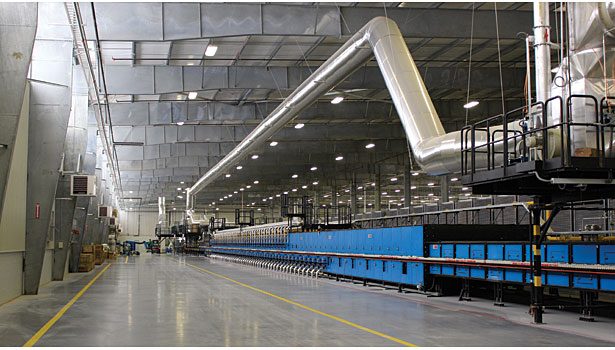A look at tile manufacturing in the U.S. shows a different picture than the one existing 20 years ago. At that time, American Olean was the only industry giant, and there were over 40 ceramic tile manufacturers of smaller and much smaller size. Today, there are seven major manufacturing companies in the U.S.: Mohawk, the largest ceramic tile manufacturer in the free world with plants in the U.S. and Mexico; American Marazzi with three manufacturing facilities in the U.S. (acquired by Mohawk in 2013); Florida Tile; Crossville; Stonepeak; Florim; and Del Conca, with one manufacturing facility each.
Stonepeak, Florim and Del Conca were not manufacturing in the U.S. 20 years ago, and they probably would not be manufacturing in the U.S. had it not been for the decline of the U.S. dollar, which made imports more expensive. Most of the companies that went out of business in the past 20 years did so for lack of resources.
Color Tile had a manufacturing plant in Mississippi for the production of wall tile; it also had a strong distribution network with over 800 company-owned stores. It did not survive because of financial difficulties. Huntington-Pacific manufactured glazed wall tile. It was overwhelmed by the technological evolution and went out of business. Interceramic, a subsidiary of a Mexican group, built a manufacturing plant in Texas, and for a while, was quoted in the U.S. stock market. After several years, management realized that it was more profitable to concentrate on the Mexican market. KPT, a subsidiary of a Taiwanese group, in 1986 invested in a plant in Indiana. It was too small to survive in the market without additional investments. Laufen International, then a subsidiary of Ceramic Holding AG Laufen of Switzerland, began its activity in the U.S. in 1985 with the takeover of the Tulsa, OK, plant of International American Ceramics. It invested heavily in distribution by taking over 17 stores of Morena Tile and Sacramento Tile.
A few years ago, the company was acquired by the Roca Group of Spain and manufacturing in the U.S. was discontinued. Mannington Mills, one of the major players in the flooring market, in 1984 purchased Mid State Tile, a mid-size quarry tile manufacturer located in North Carolina. For a while, it operated with two factories, with a second one in Mount Gilead, NC. After a few years, Mannington decided to concentrate on other flooring products and stopped manufacturing ceramic tile. Summitville of Ohio was not able to compete with superior quality imports, and went out of the ceramic tile market. United States Ceramic Tile Co., another Ohio manufacturer, was the object of an acquisition. Another company, which operated for a few years and could not survive, was Midland International Timeworks of Des Moines, IA.
The main factor that has effected these changes was Italian manufacturing technology. In the 1960s, tiles manufactured in the U.S. were mainly limited to unglazed quarry tile, glazed wall tile and unglazed mosaic. Italian manufacturers introduced double-fired glazed floor tile (Cottoforte), which offered a rich selection of designs and colors, and expanded the remodeling segment of the market. In the 1970s, singled-fired floor tiles were launched by Monocottura. This type of tile became extremely popular, and for a while, Italian imports controlled 25% of the U.S. ceramic tile market. In the 1980s, the first unglazed porcelain tile was imported from Italy, and in the late 1990s, glazed porcelain tile became the most popular item in the market. A few years ago, the Italians introduced thin tiles, which are slowly becoming a preferred product — especially in non- residential installations.
Another advantage of Italian manufacturers was the extensive use of new design. They understood that ceramic tile is a fashion product, and in order to innovate, they invested heavily in the latest technology. Besides design and technology, successful companies had to have vision and market knowledge. Logistics is also an important consideration for success in manufacturing ceramic tile. The main ceramic tile manufacturing plants are now in Tennessee, Kentucky, Alabama and Texas — clay rich regions.
American Marazzi, a subsidiary of the Marazzi of Sassuolo, Italy, was a company with a vision. The late Filippo Marazzi decided to invest in a plant in the U.S. in 1979 in order to make the company a global player. Later, Marazzi set up plants in Spain and Russia, and in 1994, it even tried a joint-venture with Penoles of Mexico. It also expanded in the U.S. by purchasing Monarch Tile and its Alabama plant. The Marazzi family had a vision, built value, and was able to sell the company to Mohawk in 2013.
American Olean, founded in 1913, was a company with a great past and image. In 1988, it was purchased for $330 million by Armstrong World, a company that aimed at becoming a global flooring supplier. The strategy did not succeed. Armstrong overpaid for American Olean and was not ready to make the investments in technology that were needed to compete with imports. American Olean lost money in 1992 and 1993, and only in 1994, was it able to make a small profit. Finally, American Olean was sold at a loss to Dal-Tile, now a division of Mohawk.
Crossville, founded in 1986 by foreign investors, was a success from the outset. The company invested in technology and was the first to produce porcelain tile in the U.S. In 1994, Crossville took over the manufacturing assets of Integrated Mosaic and Ceramic Co. (IMAC). IMAC manufactured glazed mosaics, and after a few months, the Italian owners realized that there was insufficient demand for such a product and sold the plant to Crossville. This debacle showed that technology was not sufficient to succeed in the U.S. market. Any new investment necessitated good marketing planning as well.
Florida Tile is a company with a great history and a well-recognized name in the market. In 1989, it had sales for $132 million and a strong distribution system. It was rated by Forbes magazine as one of the best small companies in the U.S. In 1990, the company was acquired by Premark International, but the acquisition did not work out as expected. By 1993, sales had declined to $90 million, and the company was burdened by a payroll of 1,450 employees. A few years ago, the Panaria Group of Italy came to the rescue, taking over the company and modernizing it.
Not all manufacturing ventures that succeeded were started by Italian investors, and not all failures were by old American manufacturers. Two Italian groups invested in the U.S., built manufacturing plants and soon after chose to sell them to American companies. Several U.S. and Canadian companies made feasibility studies prior to investing in ceramic tile plants, and, considering all the factors needed for a successful venture, wisely decided not to proceed. The companies who are manufacturing ceramic tiles in the U.S. are here because of their vision, financial resilience and understanding of the market.









.jpg?t=1690771780)

